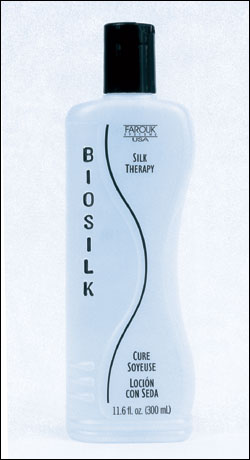IF YOU THINK styling your hair is a no-brainer, think againmaintaining this season’s coveted straight, shiny hair takes work, planning, and know-how. Whew! Silicone hasn’t been this big since the glam days of the early ’80s: It seems every line is offering a silicone- or silicone-derivative-based hair product this year. But silicone can be tricky, and misuse can turn an otherwise dreamy product into a nightmare. A couple of local experts agreed to help us help you navigate the mad world of smoothers and shine enhancers. For the best results, follow these four rules:
1. MIX IT UP Over time, silicone can build up on the hair and make it appear dull. If you use silicone-based finishing products on a regular basis, it’s important to deep clean your hair regularly with a clarifying shampoo. Mandy McCullough, a stylist at Headlines Salon (University Village, 206-527-2400), explains: “If you were painting your fingernails, and you put a clear topcoat over your fingernail polish, one coat would make it really shiny, but 12 coats would get gummy and icky and sticky. It’s kind of the same concept with silicone because it’s a shine enhancer. It’s a great productit adds shine and it’s definitely a humidity resisterbut if you continue to use it without the right products to cleanse and break that back down again, you can actually lose the effect of what silicone does.”
2. FIND YOUR BEST MATCH Silicone- and silicone-derivative-based products come in a spectrum of strengths, from light (sprays and even mousse) to medium (creams and lotions) to heavy (serums and gels). Choose yours based on your hair type. “If we have clients that have curly hair, we’re looking for a product that’s going to be humidity resistant,” says McCullough. “So if we’re straightening their hair, and we want to extend that straightness, a silicone product is nice because it works as a shield so that the hair doesn’t revert back to its frizzy or curly shape.” Marquetta Riley, a stylist at Gary Manuel Salon (2127 First Ave., 206-728-1234), suggests a silicone fluid for anybody who styles with excessive heat (like a flatiron). “Silicone products are thermal protectors as well, so it actually is forming a barrier between the heat and their hair,” she says. Someone who’s just looking to tame flyaways or add a little extra shine might be best served by a spray.
3. A LITTLE GOES A LONG WAY “People with frizz or texture are used to overusing products, [but] you can really go sparingly with silicone,” says Riley. “If you overuse it, then you have a greasy mess on your hands.
4. RECOGNIZE THE LIMITS A common mistake is to assume that silicone will moisturize or heal excessively dry or brittle hair. “You can’t necessarily look at silicone as a treatment because it’s just a topical,” says McCullough. “It doesn’t have the ability to penetrate beyond the cuticle, or the outermost layer of the hair. The effect doesn’t last through more than one shampoo.” A good strategy for repairing damaged hair is to visit your salon for regular conditioning treatments. “We have to look at the hair to make sure that we know exactly what that hair’s needingideally something with a combination of moisture and protein, with the balance of those two based on each person’s individual hair needs.” Silicone products can then be used in conjunction with the treatments to add shine.
Finally, silicone products aren’t right for all hair types. They can be effective on thick, coarse, naturally wavy, or frizzy hair, but those with fine, bodiless hair might want to steer clearsilicone could make it appear greasy and flat. There are other products on the market that might be a better fit.







